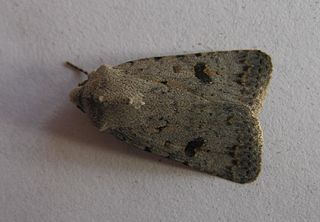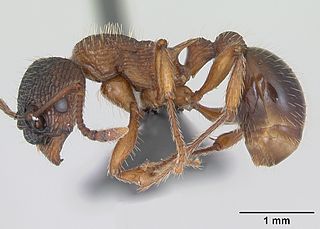
The superfamily Ichneumonoidea contains one extinct and three extant families, including the two largest families within Hymenoptera: Ichneumonidae and Braconidae. The group is thought to contain as many as 100,000 species, many of which have not yet been described. Like other parasitoid wasps, they were long placed in the "Parasitica", variously considered as an infraorder or an unranked clade, now known to be paraphyletic.

Phengaris alcon, the Alcon blue or Alcon large blue, is a butterfly of the family Lycaenidae and is found in Europe and across the Palearctic to Siberia and Mongolia.

Phengaris rebeli, common name mountain Alcon blue, is a species of butterfly in the family Lycaenidae. It was first found and described in Styria, Austria, on Mount Hochschwab around 1700. Although it was initially classified as a subspecies of P. alcon, a European researcher, Lucien A. Berger, designated it as a separate species in 1946. Genetic similarities between P. rebeli and P. alcon have led many researchers to argue that the two are the same species and differences are due to intraspecific variation.

Monochroa is a genus of moths in the family Gelechiidae.

Paradrina rebeli is a moth of the family Noctuidae. The species was first described by Otto Staudinger in 1901. It is endemic to the Canary Islands. Some authors consider the genus Paradrina to be a subgenus of Caradrina, hence the species is also known as Caradrina rebeli or Caradrina (Paradrina) rebeli.
Synodontis rebeli is a species of upside-down catfish endemic to Cameroon where it occurs in the Sanaga River basin. This species grows to a length of 26.2 centimetres (10.3 in) TL.

Monochroa cytisella is a moth of the family Gelechiidae and found in most of Europe. The larva feed in the stems of bracken causing a slight gall.
Many types of polymorphism can be seen in the insect order Lepidoptera. Polymorphism is the appearance of forms or "morphs" differing in color and number of attributes within a single species. In Lepidoptera, polymorphism can be seen not only between individuals in a population but also between the sexes as sexual dimorphism, between geographically separated populations in geographical polymorphism and also between generations flying at different seasons of the year. It also includes the phenomenon of mimicry when mimetic morphs fly alongside non-mimetic morphs in a population of a particular species. Polymorphism occurs both at a specific level with heritable variation in the overall morphological design of individuals as well as in certain specific morphological or physiological traits within a species.

Aphomia monochroa is a species of snout moth in the genus Aphomia. It was described by George Hampson in 1912 and is known from Sri Lanka and India.

Scopula beckeraria is a moth of the family Geometridae. It was described by Julius Lederer in 1853. It is found in Italy, Croatia, North Macedonia, Greece, Bulgaria, Romania, Ukraine, Russia, Turkey, Armenia, Israel, Lebanon, Iran, Turkmenistan and Kazakhstan.

Myrmica schencki is a species of ant in the genus Myrmica.
Eupithecia rebeli is a moth in the family Geometridae. It is found in Uzbekistan.

Monochroa tetragonella, the saltern neb, is a moth of the family Gelechiidae. It is found in Scandinavia, the Baltic region, Great Britain, the Netherlands and Russia. The habitat consists of saltmarshes.
Monochroa nomadella is a moth of the family Gelechiidae. It is found from southern and central Europe to the southern Ural. It is also found in Mongolia. Records of M. nomadella from France and north-western Italy refer to Monochroa bronzella. The species prefers calcareous habitats.

Monochroa rumicetella is a moth of the family Gelechiidae. It was described by O. Hofmann in 1868. It is found from Fennoscandia and Belarus to Portugal, the Alps and Greece, and from France to Romania.

Monochroa tenebrella, the common plain neb, is a moth of the family Gelechiidae. It was described by Jacob Hübner in 1817. It is found in most of Europe. The habitat consists of open grassy areas and heathland.
Monochroa absconditella is a moth of the family Gelechiidae. It was described by Francis Walker in 1864. It is found in North America, where it has been recorded from Florida, Illinois, Maine, Mississippi, New Hampshire and Ohio.

Monochroa scutatella is a moth of the family Gelechiidae. It was described by Johann Müller-Rutz in 1920. It is found in Switzerland and Italy.
Ichneumon eumerus is a species of parasitic wasp belonging to the family Ichneumonidae, subfamily Ichneumoninae. It is a specialist parasite of the larva of the mountain Alcon blue butterfly.











